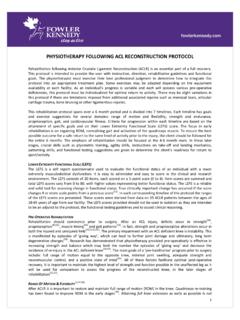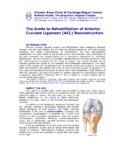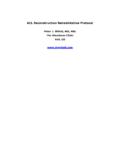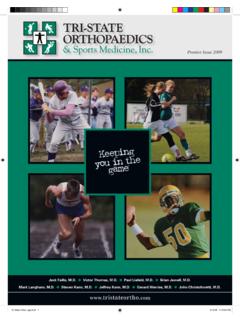Transcription of ACL TESTING SEQUENCE 4 and 6 Months - Physio South
1 ACL TESTING SEQUENCE 4 and 6 Months Some simple tests can be very useful in determining outcomes, helping to determine your readiness for returning to function. The ultimate outcome is a knee you feel is functional in every respect. However to help you achieve this we recommend the following tests which can be used not only to measure your outcome but to guide treatments. These tests are best done by your physiotherapist and a separate reporting form is attached. Subjective VAS pain (0-10) 0 = no pain and 10 the worst possible pain (any stage). Self perceived function. Compared to your pre-injury level of function how do you rate your knee now? 100% (same as before injury), 0 = worst possible knee function (any stage). Lower Limb Task Questionnaire (appendix or upon request). Hop Tests (Noyes), at 4 and 6 Months Single hop for distance ( cm; 4% SEM). Begin with toes immediately behind starting line, jump off one leg, and landing on two.
2 The hop is measured (in centimeters) from the starting line to the end of the toes after completion of the hop. The test must be demonstrated at least once and the patient is allowed one free trail hop on each leg. The injured leg is compared to the non- injured. The difference is the key measure. Expected Scores (in cm and M/F). 4 Months 6 Months Involved Leg 137/121 149/133. Uninvolved Leg 171/146 167/152. 6 meter timed hop (.34 sec; 6% SEM). Perform a single leg multiple hop for time, over a distance of 6 meters. After demonstration, the patient will be allowed one trail hop on each leg. The test begins with toes immediately behind the starting line. Hopping must commence with a single leg and each hop must be such that minimal foot contact is allowed on landing. The hop will be measured from the starting line to the end of the measured 6 meters. Each limb will be tested two times with the minimal time scored for each limb.
3 The injured leg is compared to the non- injured. The difference is the key measure. Expected Scores (in seconds and M/F). 4 Months 6 Months Involved Leg Uninvolved Leg Triple hop for distance (31cm; 4% SEM). Perform a single leg triple hop for distance with each limb. After demonstration, the patient will be allowed one trail hop on each leg. The test begins with toes immediately behind the starting line. Hopping must commence with a single leg and each hop must be such that minimal foot contact is allowed on landing. The hop will be measured from the starting line to the end of the toes on the third hop on each trail. Each limb will be tested two times with the maximal distance scored for each limb. The injured leg is compared to the non- injured. The difference is the key measure. Expected Scores (in cm and M/F). 4 Months 6 Months Involved Leg 401/343 420/362. Uninvolved Leg 496/411 483/412.
4 Cross over hop for distance (36cm; 5% SEM). With 2 strips of tape 15 cm apart and parallel. Perform a sideways hop landing each time on the opposite tape, aiming for maximum distance. Hop side to side moving forward three times and distance is measured from start to finish. The hop will be measured from the starting line to the end of the toes on the third hop on each trail. Each limb will be tested two times with the maximal distance scored for each limb. The injured leg is compared to the non- injured. The difference is the key measure. Expected Scores (in cm and M/F). 4 Months 6 Months Involved Leg 358/305 377/337. Non- involved Leg 438/362 431/376. Strength Assessments 4 and 6 Months Calculate 1 RM ( rep max = maximum strength)- this is an estimate of your one rep. max Warm up on a cycle and do some light strengthening to warm up Subjective estimation of 10 reps (ask the client to estimate a weight at which they will fail between 2 and 12 reps), full range, no secondary movement etc If they complete 12 reps, repeat; 2-3 minutes rest, add or subtract 10-20%.
5 Reassess to max (which means failure with 2-12) then multiple by the formulae below Leg extension Leg Press Reps Wathen % 1RM Reps Berger % 1RM. 2 95 2 3 92 3 95. 4 89 4 5 86 5 90. 6 83 6 7 81 7 8 78 8 83. 9 76 9 81. 10 74 10 79. 11 72 11 77. 12 71 12 75. ACL Reconstruction Post-Operative TESTING SEQUENCE Report Name_____ Physio_____. Date_____. TEST. 4 Months 6 Months Other 12 Months Left Right Diff Left Right Diff Left Right Diff VAS Pain 0-10. Function 0-100. LLTQ. LLTQ. Single hop D. 6 M Hop T. Triple Hop D. Cross Over Hop Quads Est 1RM. H Est 1RM. Comments







